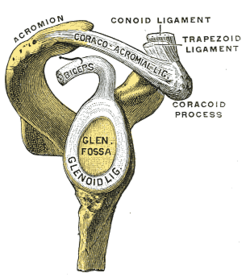| Glenoidal labrum | |
|---|---|
 Lateral view of the shoulder showing the glenoid labrum (marked "glenoid lig.") | |
| Details | |
| Identifiers | |
| Latin | labrum glenoidale |
| TA98 | A03.5.08.002 |
| TA2 | 1765 |
| FMA | 23290 |
| Anatomical terminology | |
The glenoid labrum (glenoid ligament) is a fibrocartilaginous (but not fibrocartilage, as previously thought) structure attached around the rim of the glenoid cavity on the shoulder blade. The shoulder joint is considered a ball-and-socket joint. However, in bony terms the 'socket' (the glenoid fossa of the scapula) is quite shallow and small, covering at most only a third of the 'ball' (the head of the humerus). The socket is deepened by the glenoid labrum, stabilizing the shoulder joint.[1][2]
The labrum is triangular in section; the base is fixed to the circumference of the cavity, while the free edge is thin and sharp.
It is continuous above with the tendon of the long head of the biceps brachii, which gives off two fascicles to blend with the fibrous tissue of the labrum.
- ^ Carter, Kevin.; Mudigonda, Sanjay. (1 January 2009), Weissman, Barbara N. (ed.), "Chapter 5 - Arthrography and Injection Procedures", Imaging of Arthritis and Metabolic Bone Disease, Philadelphia: W.B. Saunders, pp. 60–80, doi:10.1016/b978-0-323-04177-5.00005-7, ISBN 978-0-323-04177-5, archived from the original on 1 November 2020, retrieved 25 October 2020
- ^ Lodha, Sameer; Mazloom, Sean; Resler, Amy G.; Frank, Rachel M.; Ghodadra, Neil S.; Romeo, Anthony A.; Kim, Jonathan Yong; Jadgchew, R. Jason; Provencher, Matthew T. (1 January 2018), Giangarra, Charles E.; Manske, Robert C. (eds.), "24 - Shoulder Instability Treatment and Rehabilitation", Clinical Orthopaedic Rehabilitation: a Team Approach (Fourth Edition), Philadelphia: Content Repository Only!, pp. 130–157.e1, ISBN 978-0-323-39370-6, archived from the original on 31 October 2020, retrieved 25 October 2020